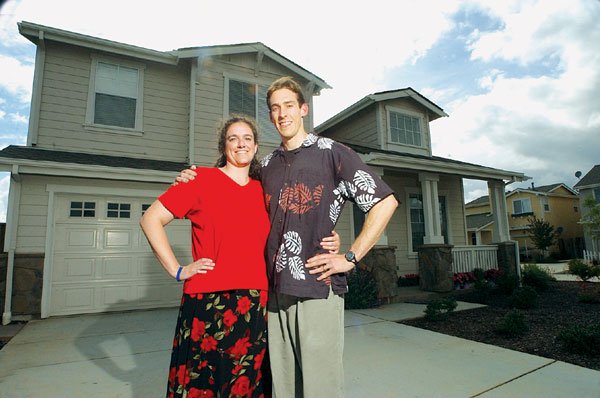Gilroy
– Local teachers Mandy and Sean Reedy needed help from four
government agencies to make their first one possible. Newlyweds
Bertie Simon and James Rich saved for nearly a decade before their
dream came true. And dozens of others had no choice but to help
build theirs.
Gilroy – Local teachers Mandy and Sean Reedy needed help from four government agencies to make their first one possible. Newlyweds Bertie Simon and James Rich saved for nearly a decade before their dream came true. And dozens of others had no choice but to help build theirs.
There’s no question that buying a first home in Gilroy requires a lot of creativity and a little luck for low- and middle-income earners, who have seen home prices in Gilroy soar well beyond their means in recent years.
According to census statistics, more than half the families in Gilroy fall well below income levels needed to secure a median-priced home, which stood at $665,000 in March. A home in that price range requires a yearly income of about $137,000, according to South County Housing, the city’s nonprofit housing provider.
“We had wanted to buy a house but it didn’t look possible in Gilroy,” said Mandy Reedy, a 26-year-old teacher at Rod Kelley Elementary School. She and her husband Sean, a 29-year-old who teaches at South Valley Middle School, earn a combined income of $80,000. That kept them out of the running two years ago for a $456,000 house on north Church Street.
Today, the couple is living in that home, but only through a unique loan package put together by South County. In addition to providing them with a $5,000 loan, the agency connected them with $30,000 from the city and $5,000 from the Gilroy Unified School District. Most of the remainder came from the California Housing Finance Agency, as well as their parents and credit cards.
In total, the financing package trimmed $77,000 from the final cost of their home, which they moved into in September.
“We never really were on the market because we knew we couldn’t do it,” Mandy Reedy said. “We really lucked out – South County Housing did all the creative financing.”
The Reedy home was part of the nonprofit group’s project known as La Maestra, a mixed development of market-rate and below-market-rate homes in north Gilroy. In recent years, South County has also created affordable housing communities such as Los Arroyos, which mixes housing types for a variety of income ranges, and Summerhill, where neighbors helped build homes for each other to reduce costs.
South County is now working on several projects, one at the northern end of Monterey Street and another in the downtown area at the site of the old cannery, off Lewis Street. The projects, which will bring more than 100 new affordable units to the city, are now passing through the regulatory process.
But only a fraction of eligible families are fortunate enough to take advantage of South County’s offerings.
Others, such as Bertie Simon, 49, and James Rich, 50, have had to rely on patience and a little luck.
The couple, who married four and a half months ago, have been on the housing market for two years. Simon is a caseworker for Monterey County Child Support Agency and Rich is a delivery truck driver in the San Jose area. Their combined household income is $90,000, but that was enough to land them a $480,000 home in Oak Commons.
Rich noticed the housing community going up south of First Street behind Blockbuster while on his delivery route last fall. The project includes 137 houses, most of them three bedroom models measuring 1,600 square feet.
Affordability was not a big issue, Simon said, in part because they locked in a price under $500,000 as one of the first 10 buyers.
“We both had savings and we got together and pooled our monies,” Simon said. “That was also a big help.”
Since the couple secured their home in October, prices in Oak Commons have shot up into the low- and mid- five hundred thousand-dollar range, according to a sales representative. And those prices are still considerably cheaper than many homes in the city’s core.
Amidst the home-buying frenzy, many people are resorting to aggressive tactics to stay competitive.
“Most of the loans that are going through now are ‘stated,'” explained Peter Casper, a loan officer at Diversified Capital in Gilroy. “Stated” loans, as they are known, do not require verification of actual income, leaving applicants free to pad their earnings on paper and qualify for larger amounts.
“It has to be reasonable,” Casper said, explaining that lenders know, for instance, that a software engineer in Silicon Valley likely earns between $125,000 and $200,000 annually.
Even more prevalent than overstating earnings is the reliance on zero-down payment and “interest-only” loans, meaning monthly payments never go toward reducing actual debt.
“Nobody even thinks about paying a loan off anymore when housing is concerned,” Casper said. “By increasing equity, they end up borrowing to replace the initial loans. You don’t get the greatest interest rates, but you don’t have anything to lose. What’s happening is that the values of the properties are going up so quick and so high, buyers come back sometimes in a couple months and want to do a 30-year fixed loan.”
Casper admitted that many first-time buyers are assuming a hot real estate market will continue driving up the value of their new homes. But that’s one gamble where people seem to like the odds.
“Anything’s possible,” Casper said, “but the demand is still there, and it looks like it’s going to be there for as long as anyone can see.”
For information about South County Housing’s affordable housing projects, call 842-9181.
To learn more about Oak Commons, visit www.obriengroup.com or call 842-9172.















